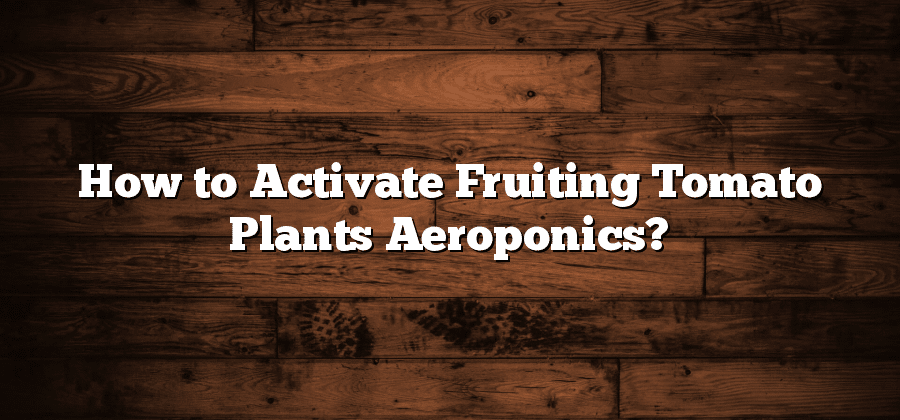Choosing the Right Tomato Varieties for Aeroponics
There are numerous tomato varieties available for cultivation in aeroponic systems, each with its own set of characteristics and requirements. When choosing the right tomato variety for aeroponics, it is crucial to consider factors such as growth habit, disease resistance, taste, and overall plant vigor.
One popular tomato variety that performs well in aeroponics is the “Cherry Bomb” tomato. This variety is known for its high yield potential and disease resistance, making it a reliable choice for aeroponic growers. Another excellent option is the “Beefmaster” tomato, which is prized for its large fruit size and exceptional flavor. By selecting tomato varieties that are well-suited to the aeroponic environment, growers can maximize their chances of success and achieve optimum crop production.
Understanding the Basics of Aeroponics for Tomato Plants
Aeroponics is a modern and innovative method of growing tomato plants without the need for soil. Instead, plants are suspended in air and their roots are sprayed with a nutrient-rich mist. This mist is delivered through a high-pressure system, ensuring that the plant roots are able to absorb an adequate amount of nutrients for optimal growth and development. This unique approach to cultivation offers numerous benefits, including increased plant growth rates, improved nutrition absorption, and reduced water usage compared to traditional soil-based growing methods.
One of the key advantages of aeroponic cultivation for tomato plants is the ability to control and optimize the growing environment. With aeroponics, growers have the flexibility to adjust various factors such as temperature, humidity, and nutrient levels to create the ideal conditions for tomato plant growth. By carefully monitoring and maintaining these conditions, growers can maximize the yield and quality of their tomato harvests. Additionally, since the plants are not grown in soil, the risk of soil-borne diseases and pests is significantly reduced, resulting in healthier and more resilient plants.
Preparing the Aeroponic System for Tomato Plant Cultivation
When it comes to preparing the aeroponic system for tomato plant cultivation, attention to detail is crucial. Before starting the process, it is important to thoroughly clean and sterilize all components of the system to prevent the growth of harmful bacteria or pathogens. This can be done by washing the reservoir, tubing, and spray nozzles with a mild bleach solution, followed by thorough rinsing with clean water. Additionally, ensuring that the system is properly set up and functioning correctly is essential for the successful growth of tomato plants. Each component, including the pump, timer, and spray system, should be checked for any malfunctions or leaks, and replaced or repaired if necessary. By taking the time to properly prepare the aeroponic system, one can create an optimal environment for tomato plant cultivation, resulting in healthy and productive plants.
Providing Adequate Lighting for Tomato Plants in Aeroponics
To ensure optimal growth and productivity of tomato plants in aeroponics, it is crucial to provide them with adequate lighting. Unlike traditional soil-based cultivation, tomato plants in aeroponics rely heavily on artificial lighting systems to satisfy their energy needs. The right lighting conditions not only promote healthy growth but also contribute to higher fruit yields.
When selecting lighting options for your aeroponic tomato plants, it is important to consider the intensity and duration of light exposure. High-intensity discharge (HID) lamps, such as metal halide (MH) and high-pressure sodium (HPS) lamps, have been proven effective for providing the necessary spectrum of light for tomato growth. These lamps emit a balanced combination of red and blue wavelengths, promoting photosynthesis and influencing the formation of sturdy stems and healthy foliage. Additionally, LED grow lights have gained popularity in recent years due to their energy efficiency and ability to produce specific light spectra, tailored to the needs of tomato plants.
Maintaining Proper Nutrient Levels for Tomato Plants in Aeroponics
Tomato plants grown in aeroponic systems require a careful balance of nutrients to thrive and produce a bountiful harvest. Maintaining proper nutrient levels is crucial to ensure the plants receive the necessary elements for healthy growth and development.
One important aspect of nutrient management in aeroponics is to monitor the pH level of the nutrient solution regularly. Tomato plants prefer a slightly acidic environment with a pH range of 5.8 to 6.3. To maintain the desired pH level, it is advisable to use pH testing kits or electronic meters to measure the acidity of the solution. Adjustments can be made by adding pH up or down solutions to reach the optimal range. It is essential to check the pH level frequently as fluctuations can occur due to nutrient uptake or pH drift, which can impact the overall health of the tomato plants. Expert growers also recommend monitoring the electrical conductivity (EC) of the nutrient solution to ensure the plants receive the right amount of nutrients. By regularly testing and adjusting the EC, growers can avoid over or underfeeding their tomato plants, leading to better growth and higher yields.






